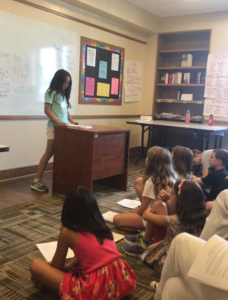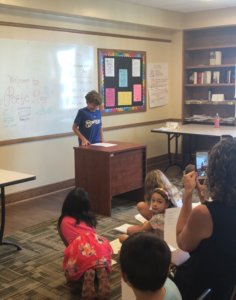Summer SAVY 2018: Session 5, Day 5 – Poetic Play (Rising 3rd/4th)
Happy Friday, and a very happy, celebratory, and rejuvenating last day of Poetic Play to all! I am, as ever, grateful to all the students this week for creating such a wonderful class community of respect, awe, and courage in themselves as rising writers, and in the world around them! Thank you, thank you.
A brief recap of our day today—
This morning, we played a last round of Exquisite Corpse collaborative writing game as a class. We switched up the rules a bit from earlier in the week. This time, all students began with the line by e.e. cummings, “who knows if the moon’s a balloon,” from the poem Who Knows If The Moon‘s. Students then had the opportunity to add on to this line. They folded over their papers so that only their prior line was showing (not the entire poem!), and passed to the next student. Each time they wrote a line, they folded over their paper so that only THEIR written line was showing. This way, students received poems where they had to deduce meaning from only one line of a poem (rather than an entire stanza), and this, in turn, created wonderful and stumping challenges for each writer — how to add elements of surprise, meaning, and inventiveness into their work. When students got their final poems back, we had a mini share-around, and discussed how surprise might be a part of the writing process. You may, for example, begin your poem in one direction, and end up in a completely different one!
This transitioned nicely into our Poetic Quote of the Day, “No tears for the writer, no tears for the reader. No surprise for the writer, no surprise for the reader,” by great American poet Robert Frost. Students discussed in their groups whether or not they agreed, disagreed, or wanted to revise this quote. We then came together as a whole class to talk about how readers and writers might offer different interpretations on the same literary text. We decided that all great literature — books that truly transform us, and move us — inhabit elements of emotion (tears, emotional metamorphosis) and surprise. As writers, we discussed strategies for inserting surprise into our own writing process, such as writing prompts, inserting new or fantastical images into our poems, and even experimenting with the sounds of language.
In order to think actively about the Sounds of Language some more, we read “Jabberwocky,” by Lewis Carroll, one of my personal favorites to teach young writers! Students were given a brief introduction into “Nonsense Poetry,” a broad category of poetry used to describe poems that are composed of “nonsense,” or made-up, words. I talked to students about the ways that Carroll, while writing in 19th Century England, attempted to resist his time’s cultural discussion on “proper” ways of using English language by inventing as many nonsensical, creative words as he could. By doing so, he tapped into the instinctive sounds of English language that create vivid images in speaker’s heads. In “Jabberwocky,” which we read as a class, we deciphered the basic storyline: a boy is told by his father to kill the beast of the Jabberwock, which he does, and returns home triumphant. We focused on specific nonsensical words, such as: “snicker-snack,” “vorpal sword,” and “galumphing.” We discussed how the consonants and noises in each of these words creates different imagistic effects in our minds. Galumphing, for example, places a stressed syllable on the “u,” and thus, sounds like a bit of a skip or a gallop when spoken into the air. Vorpal, meanwhile, has very sharp and swift “V” and “P” noises — mimicking a sword coming down on a hard surface. As poets, we can use tools such as consonance, assonance, and alliteration, and pay attention to the sounds of words in order to set mood/tone for our readers.
After our reading of the Jabberwocky, students worked on creating short Introductions for their Open House Poetry Reading this afternoon. We discussed providing very brief contextual information for poems that we’d like to read, in order to better orient the reader.
Students had a break for ORA (Rec), and we returned to the classroom with a lesson on being Dynamic (Out Loud) Readers. We watched a short excerpt from the spoken word poet Sarah Kay’s poem, “If I Should Have A Daughter.” Students were asked to reflect on what linguistic, bodily, and gestural cues Kay uses in her out-loud performance to amplify the message of her poem. We talked about delivering poems with conviction and emphasis, and about being confident readers with well-paced deliveries.
We moved into a practice round of the Open House Poetry Reading, where students had an opportunity to practice reading their poems out loud to one another using dynamic reading techniques, first in small groups, and then, as an entire class. We offered each other constructive feedback and questions.
Students then had a chance to learn a little about Erasure Poetry (also known as Blackout Poetry) through Lorca’s “Guitar.” Students were given copies of Lorca’s poem, and invited to erase specific words in the poem in order to create new meaning, to “re-vision” or re-see the poem into something fresh and different. We continued this exercise both before and after lunch.
After sharing our erasure poem versions of “Guitar” with one another, we moved into the next round of the day — a Q&A session with Miss Carlina and Miss Cristina, the instructor and TA! Since Miss Cristina and I both already have or are attaining our MFAs and have experience with publishing in the writing world, we each demonstrated a tiny reading for the class, sharing 3 minutes of our own personal work. We then invited the students to think about questions they may have for the real writing life, as practiced by two current writers. Students were invited to ask us anything about the publishing process, the writing itself, ideas, writing history, background, advice, etc.
We took a quick break, and had a Review of all the key terms and techniques we have learned together throughout the week. Students were given the chance to fill out Concept Maps once more, in order to see how they’ve taken this new knowledge and applied it to hopefully expansive notions of poetry. Students completed course evaluations, and we prepped the room for the Open House, which commenced shortly thereafter!
Thank you all for a wonderful week in Poetic Play. I hope you continue to have outstanding summers; may your writing journeys be long, fruitful, and full of fun.
Please note: There is a references list on the back of your student anthologies for more Poetry Resources. In case you’d like it via blog form, here it is, again, below:
Cool Poetry Archives/Resources…
Poem-a-Day: https://www.poets.org/poetsorg/poem-day
Academy of American Poets: https://www.poets.org/
The Poetry Foundation: https://www.poetryfoundation.org/
For learning about Form Poems… (sonnets, haiku, etc.)
Poetic Forms (Collection): https://www.poets.org/poetsorg/collection/poetic-forms
For rhyming…
Rhyme Zone Rhyming Dictionary: https://www.rhymezone.com/
For more juicy adjectives and vibrant verbs…
Merriam Webster Thesaurus: https://www.merriam-webster.com/thesaurus
For subscribing to poetry (and literature-related) magazines:
Cricket Magazine: https://shop.cricketmedia.com/
with gratitude, and well wishes for your future writing careers ahead!
Miss Carlina
Photos From Open House



